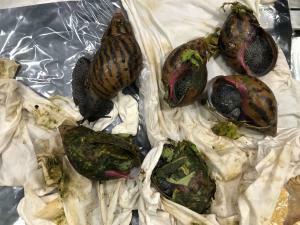Section Branding
Header Content
Giant African snails, a voracious invader, are intercepted at Detroit's airport
Primary Content
Most snails move slow, but these illicit gastropods crossed the Atlantic at hundreds of miles per hour.
Customs officials at Detroit Metropolitan Airport recently found six living snails inside a suitcase of a traveler who flew from Ghana, U.S. Customs and Border Protection announced Friday.
Agriculture specialists confirmed that the creatures with dark brown stripes were indeed giant African snails — a prohibited, invasive breed that the U.S. diligently has worked to eradicate from the country for more than 50 years.
While they appear harmless, these land snails — usually the size of an average adult fist — are considered voracious pests that can feast on more than 500 types of plants and produce, including peanuts, beans and cucumbers. When those are not available, they will consume flowers, tree bark and even the paint and stucco off of houses.
Giant African snails also are known to carry parasites that can lead to meningitis and other diseases in humans. And they reproduce quickly, laying as many as 1,200 eggs in a single year.
When the snails were found living wild in southern Florida back in the 1960s, it took more than 10 years and $1 million to eradicate them. The were found to have invaded the state again in 2011, launching another decade-long removal effort.
Over the years, the animal has stubbornly reappeared in the U.S. — partly because they are a local delicacy in West Africa. When cooked properly, these snails can serve as finger food or bar snacks, Miami member station WLRN reported back in 2013. They're also sometimes kept as pets, the USDA says.
Today, giant African snails are believed to be in the wild in Florida, Hawaii and parts of the Caribbean, according to the U.S. Department of Agriculture.
If you stumble on these creatures, federal authorities recommend contacting a local state department of agriculture or a local branch of the USDA Animal and Plant Health Inspection Service.
Copyright 2023 NPR. To see more, visit https://www.npr.org.


